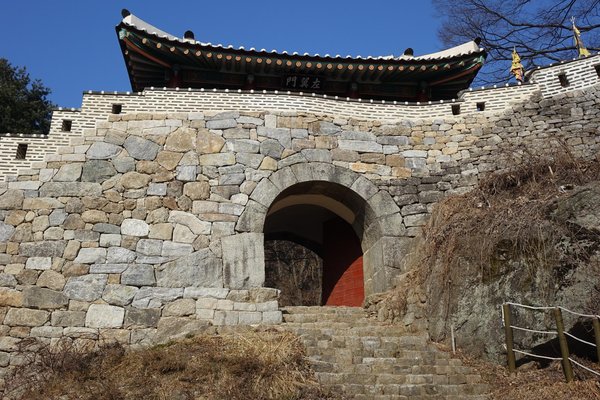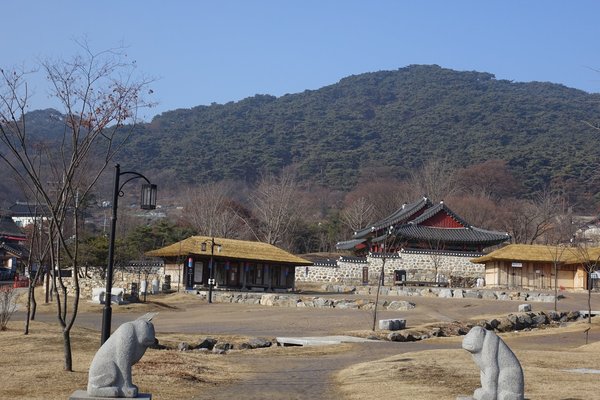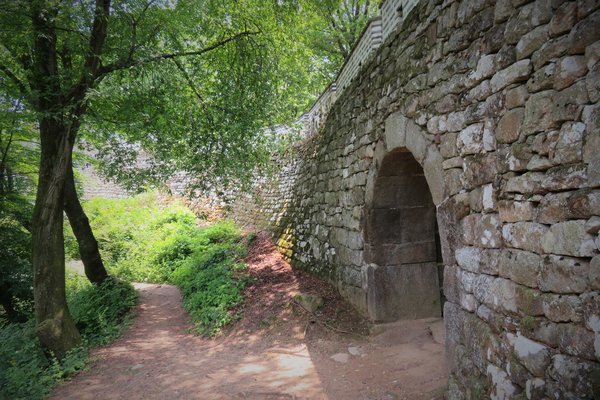Republic of Korea
Namhansanseong
Namhansanseong is a mountain fortress that shows a synthesis of the new defensive military engineering concepts of the period.
The fortress was designed as an emergency capital for the Joseon dynasty in the early 17th century. Its architecture is a fusion of Korean, Chinese, Japanese and European military fortification concepts, designed for the use for the first time of Western firearms. Within the walls were military, civil and religious buildings, and it was manned by Buddhist monk-soldiers.
Community Perspective: it’s an easy day trip from Seoul by metro and bus, and you probably will meet “hundreds of fully equipped local hikers from all ages”. The lovely surroundings and views are the main reasons to visit. Kyle hiked the entirety of the wall and visited the outer portions, Clyde visited the serene Buddhist temples of Mangwolsa and Janggyeongsa, and GabLabCebu the Yeonjubong Outwork, culminating in the watchtower at Yeonjubong Peak. The second location (“two Sinnam advanced defensive posts”) so far is unreviewed.
Site Info
Official Information
- Full Name
- Namhansanseong (ID: 1439)
- Country
- Republic of Korea
- Status
-
Inscribed 2014
Site history
History of Namhansanseong
- 2014: Inscribed
- Inscribed
- Type
- Cultural
- Criteria
- ii
- iv
Links
- UNESCO
- whc.unesco.org
- Official
-
- english.visitkorea.or.kr — Namhansanseong on the Visit Korea website
All Links
UNESCO.org
- whc.unesco.org — whc.unesco.org/
Official Website
- english.visitkorea.or.kr — Namhansanseong on the Visit Korea website
Community Information
- Community Category
- Secular structure: Military and Fortifications
Travel Information
One million visitors or more
Seoul hotspot
Recent Connections
-
Perfect Inscriptions
2014 -
Cultural WHS set within an IUCN recognised protected area
Namhansanseong IUCN Category V (Provinc… -
WHS with enclave
One enclave, village of Namhansanseong.…
Connections of Namhansanseong
- Individual People
-
-
Hendrick Hamel
Because Joseon did not inform the Qing Dynasty about the 36 Dutch survivors of a shipwreck and did not want to explain the reason of their stay in Seoul, Hamel and his mates were moved to Namhansanseong in the suburb of Seoul and they were kept on a close watchSee www.hamel.go.kr
-
Isabella Bird
"The first two days were spent in turning the flank of the range on which is the so-called fortress of Nam Han, with its priest soldiers, one of the four which are supposed to guard Seoul and offer refuge in times of trouble. On the right bank there are many villages of farmers, woodcutters, and charcoal burners. After circumventing the fine fortress summit of Nam Han, the river enters the mountains. From that time up to the head of possible navigation, the scenery in its variety, beauty, and unexpectedness exhausts the vocabulary of admiration." - Korea and Her Neighbors (pg. 83, 84)
-
- Trivia
-
-
Dragon
Yeonmugwan (Hall of Practicing Martial Arts) is massive, with a floor space of some 330 square meters, and is placed on a high foundation, making it visible from a distance. Crossbeams inside the hall have dragon images painted on both sides, while phoenixes are painted on the side beams. - official website -
One million visitors or more
"The number of visitors has increased from less than one million per year to more than 3 million (2010)." - AB Evaluation
-
- History
-
-
Joseon Dynasty
emergency capital for the Joseon dynasty -
Fusion
"It bears witness to a synthesis of both military and urban concepts stemming from Korean, Chinese, Japanese and European influences, with the use for the first time of Western firearms." - AB Evaluation -
Sieges and Battles
Qing Emperor Taizhong led an invading force of 130,000 onto the Korean Peninsula in the 12th moon of 1636. The Joseon army at Namhan Mountain Fortress totaled a mere 12,000 men, meaning they were outnumbered by more than ten to one. The Qing soldiers were also much better trained. Despite such overwhelming odds against them, the Joseon side managed to resist for 47 days. - official website -
Contains significant structures from the 21st Century
Emergency Palace or Namhansanseong Palace: "Completely destroyed in the early 20th century, the site of the royal palace and its shrines was excavated (1999), and then reconstructed (2004)." - AB Evaluation -
Insurrections
The "righteous army" guerrilla forces who rose up in 1896 considered Namhan Mountain Fortress to be their base of operations. The 1,600 or so soldiers who gathered there consisted of units from Gwangju, Icheon and Yanggeun. They intended to join guerrilla bands from the three southern regions (Gyeongsang, Jeolla and Chungcheon), advance on the capital to chase out the Japanese troops stationed there, and reinstate Gojong as Emperor. Their plans were thwarted, however, the Japanese authorities knew that Namhan Mountain Fortress was a hotbed of resistance. Therefore, Japanese troops removed all the weapons there in 1907, blowing up the gunpowder found on the site, burning all the temples down, and destroying many of the other structures. Yet, the fortress continued to be a staging area for resistance operations during the Japanese Colonial Period, including the March 1st Independence Movement in 1919. - official website
-
- Ecology
-
-
Notable Trees
"A zelkova in front of Pavilion for Command and Military Training is assumed to be 510 years old, and it is designated as a Protected Tree of Gwangju City, No 14. It is 24m in height and 8.9m in circumference." - Nomination File
-
- Architecture
-
-
Brick architecture
"The parapets are made of grey bricks for shock absorption from cannon attacks, and this was done in accordance with the opinions of the School of Practical Learning who were much influenced by the Chinese." - Nomination File -
Wooden architecture
Key wooden structures within the fortress. Temporary Palace - Haenggung, Command Post Sueojangdae, Shrine Sungryeoljeon - Cheongryangdang - Hyeonjeolsa, Arsenal Chimgwaejeong, Martial Arts Training Hall- Yeonmugwan, Pavilion Jisudang, Janggyeongsa Temple. - official website
-
- Damaged
-
-
Damaged in War since WWII
Korean War "In 1951, during the Korean War, Namhansanseong was seriously damaged by bombardment." AB
-
- World Heritage Process
-
-
Perfect Inscriptions
2014 -
WHS with enclave
One enclave, village of Namhansanseong. (Map of Inscribed property)See whc.unesco.org
-
- Religion and Belief
-
-
Confucianism
"Its town planning reflects Chinese Confucian influences; it reproduces the city plan of Seoul in order to accommodate the administration and the population in similar conditions if they were forced to move in the event of war." - AB Evaluation -
Legends and Folk Myths
According to legend, King Onjo appeared to King Injo in a dream during the Manchu Invasion of 1636. The Baekje founder told the Joseon monarch he would be isolated standing alone and urged him to join with subjects who had outstanding reputations. - official website
-
- Human Activity
-
-
Festivals
Namhansanseong Cultural Festival (October) -
Irrigation and drainage
"As the entire Namhansanseong Fortress was mostly constructed along with mountain slopes, water permeating into the fortress walls could threaten the stability of the fortress walls. Accordingly, separate water drain holes were installed in places where the drainage system was not good. So far, 28 water drain holes have been verified." - Nomination File
-
- Constructions
-
-
Stelae
"Lastly, the property includes a series of epigraphic steles, mainly commemorating the construction of the rampart, or related to human and social virtues, or linked to initiatives for the reconstruction or preservation of the property." AB Evaluation
-
- WHS on Other Lists
-
-
Cultural WHS set within an IUCN recognised protected area
Namhansanseong IUCN Category V (Provincial Park)
-
- Timeline
-
-
Built in the 17th century
it has earlier origins, but was rebuilt 1624-1626
-
- WHS Hotspots
-
-
Seoul hotspot
< than 25km from the city center, just outside of Seoul proper
-
- Visiting conditions
- WHS Names
-
-
Named after a Mountain
Namhan Mountain - 480m
-
- Literature & Film
-
-
Poetic Quotations
Sijo on the Fortress (18th century): "The Fortress appears to be protected by dragons and tigers; its warriors who protect this large area are as strong as wild beasts. The great king's virtue is passed on and the general treats its subordinates with benevolence and righteousness. In this world, we take charge of both sericulture and defense, but in our free time, we also sing and play games. You might be ashamed of not defeating your enemy, but always keep this in mind and never forget this painful feeling." - Hannamnu Pillar inscription at the entrance of the Haenggung Palace of Namhansanseong (official website)
-
News
No news.
Recent Visitors
Visitors of Namhansanseong
- Alejandro Lau
- Alexander Lehmann
- Alexander Parsons
- Alex Goh
- anthonybonbon
- Atila Ege
- Bernard Joseph Esposo Guerrero
- Bill Maurmann
- bossc
- c82wc1
- Can SARICA
- Carlo Sarion
- Casey
- Chalamphol Therakul
- chenboada
- Cheryl
- Christoph
- Christravelblog
- ClaraHH
- Clyde
- Colossus
- Csaba Nováczky
- CugelVance
- cutecid
- Daniel Chazad
- Dimitar Krastev
- DouglasR
- Dr. Caligari
- Elaine McArdle
- Elisabeth Fransisca Situmorang
- Els Slots
- Errol Neo
- Eva Kisgyorgy
- Fan Yibo
- Frederik Dawson
- GabLabCebu
- Garrett
- GeorgeIng61
- Hadrianus
- Harry Mitsidis
- henryjiao18
- Iain Jackson
- inomusay
- Janos
- Jan Zimmermann
- Jarek Pokrzywnicki
- Javier
- Jeffrey Chai
- JL
- J_neveryes
- Joel on the Road
- Jonas Kremer
- Jon Opol
- Joyce van Soest
- Kasper
- Ken DJ
- kiank37
- Kristin
- krtek
- Kyle Magnuson
- Lee Kai Loong
- lichia
- Loic Pedras
- Luboang
- Lucio
- Ludvan
- Luis Filipe Gaspar
- Lukasz Palczewski
- Luke LOU
- Maciej Gil
- Martin
- Matthewsharris
- MaYumin
- Michael Ayers
- Michael Novins
- Michael Turtle
- Mihai Dascalu
- Mikko
- Naim Y
- nan
- Nihal Ege
- Olli-Pekka Turunen
- Patrik
- Paul Schofield
- Pchxiao
- Peter Lööv
- Philipp Peterer
- Ralf Regele
- ReallyDeepThoughts
- Roman Bruehwiler
- Sergio Arjona
- Shandos Cleaver
- sibariam
- Simonh
- Solivagant
- Stanislaw Warwas
- Stijn
- SymonMajewski
- Szucs Tamas
- Taotao Chen
- Thomas Buechler
- tony0001
- trish91198
- Vincent Cheung
- voyager
- Xiong Wei
- Xiquinho Silva
- Yongcheng Liu
- Zoë Sheng
- Zos M
Community Reviews
Show full reviews
Time of the visit: the 3rd of nov.,2025
The Namhansanseong Fortress is a mountain fortress located southeast of Seoul, built to defend the capital during times of invasion. It served as a strategic military stronghold with walls stretching over 12 km. The site became a temporary capital in emergencies.
It was a quite tiresome journey to reach Namhansanseong by public transport.Although Namhansanseong seems like it's just a stone's throw from Seoul, the reality is quite different. I had to take three different metro lines before reaching the "Sanseong" metro station. From there, I took bus number 9, which runs every 20 minutes. More than two hours of travel time. Very unpleasant.
My intention was to get off at the stop by the Provisional Palace. I spontaneously changed my plans and got off at the South Gate, which later proved to be an excellent decision.
At the South Gate I carefully studied the walking routes and decided to walk from there to the East Gate.
It took me approximately 60-75 minutes to reach the East Gate, during which time I frequently took photos and admired the scenery. Along the way, I also went through a so-called secret door to view the wall from the other side.
At the East Gate I turned into the inner heart of the fortress, so to speak. The fortress center basically consists nowadays of restaurants, cafes, a police station, a Korean version of a church, and a small temple, but few residential buildings.
The provisional …
Keep reading 0 comments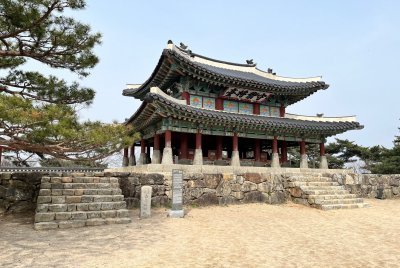
Getting around Greater Seoul is efficient and cheap with public transport. A T-Money Card is highly recommended. One can easily reach Namhansanseong by Seoul Metro, transferring to bus - the latter are well-kept and provide excellent Wi-Fi. On weekends, get off at Sanseong metro station and transfer to bus 9-1. From Mondays to Fridays, either transfer to bus 9 there or transfer to bus 9 or 52 at Namhansanseong metro station. To beat the crowds, avoid the weekends!
My visit was on a Wednesday in late March 2024 and was not crowded at all. I started at Haenggung/Namhansanseong Palace, then walked to Bukmun/North Gate and from there counterclockwise close to the outer walls. Just before reaching Seomun/West Gate, at the northernmost point of the wall, one can exit at "Secret Entrance No. 5" to reach "Yeonjubong Ongseong", the watchtower with the panorama that GabLabCebu shared. I agree with the fellow WHS traveller that this is the first highlight, followed by Sueojangdae/West Command Post [picture].
Overall, despite the leafy setting, I found this site to be less picturesque than the Suwon City Walls/Hwaseong Fortress. The distances to walk are very similar to Suwon and so are the ascents and descents. Please note that vending machines can only be found close to Haenggung/Namhansanseong Palace, so bring enough beverages. One does not need to walk the full loop but may shortcut by taking a bus 9 or 52 back to the metro stations from the bus stop closest to Nammun/South Gate.
Keep reading 0 comments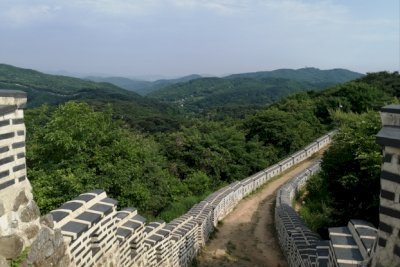
Despite the low number of reviews, I would say Namhansanseong is covered pretty well by its earlier visitors, and I don't have all that much to add. In June 2023, I came the same way everyone seems to come (including all the elderly hikers that filled the bus to the brim) and walked the commonly covered stretch between the Northern Gate and Western Command Post, and short of a couple of highlights, the overall experience seems to be the same for everyone. This is a mountain fortress, nothing more and nothing less. It's honestly an impressive one at that; for its size and the terrain it covers, Namhansanseong was definitely no easy feat. That being said, you'll mostly be admiring the views and the nature much more often than the structures of the actual fortress. I found the gates and command posts in Hwaseong to be more impressive and better preserved. The Northern Gate seemed to be under renovation, sadly, but I did see the Western Gate, Cheongryangdan Shaman Shrine, the Western Command Post (probably the most impressive and important structure), and Gukcheongsa Temple, as well as the Emergency Palace. Most of my nearly 2-hour visit was walking, as the terrain definitely slows one down - the hike from the central roundabout up to the northwestern fortress walls is quite steep. To me, the best part of the visit was the Yeonjubong Outwork, culminating in the watchtower at Yeonjubong Peak (picture attached). From here, you have an incredible view of …
Keep reading 0 comments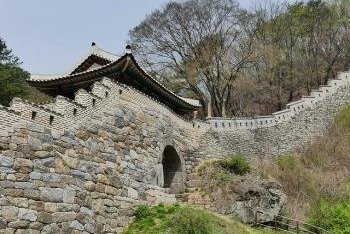
I visited this WHS in April 2017. Located on Mt. Namhansan mountain, this fortress seems to be the preferred inscribed fortress among locals mostly because of the nature trails and hikes in the provincial park. I spotted a couple of interesting birds plus several common and black squirrels along the way.
In Spring, the fortress wall and pavilions are hidden well in the thick acacias. The loop hike is a medium difficulty 7.5km hike but is less photogenic and striking overall than Hwaseong and has less impressive defensive structures. Apart from the gates, the Emergency Palace is worth visiting.
My personal highlight was visiting the serene Buddhist temples of Mangwolsa and Janggyeongsa built by Buddhist monk-soldiers. These are situated 500-800 metres from the East Gate on a very steep hill. Both temples were fully decorated with colourful lanterns for Buddha's birthday when I visited. The UNESCO inscription plaque is just next to the tourist information booth near the Emergency Palace (closed on Mondays) and there is another stone marker near the East Gate.
To get to Namhansanseong it takes around 90 minutes. First you have to get to Sanseong Station by subway (exit 2) and then catch bus number 9 (all buses accept T Money Cards but you can also pay the driver directly). The afternoon return buses are very frequent so wait for one with enough free seats to go down the several hairpins!
Overall I enjoyed my visit but I'd rank it only slightly better than the Ganghwa …
Keep reading 0 comments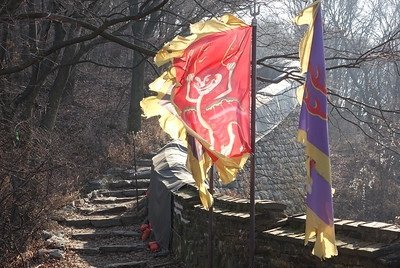
Namhansanseong was the ‘contingency capital’ for the Korean Joseon Dynasty, built as a mountain fortress in the early 17th century. I visited it on a day trip from Seoul – although it lies only some 25km outside of the capital, it took me 1.5 hours to get there by metro and bus. Looking at the number of large parking lots and restaurants, the site must see huge weekend crowds (over 3 million visitors already in the year 2010, before WH inscription!).
On a weekday though, the place is the domain of elderly hikers. Most of them actually got off one bus stop earlier than I did, for the start of the trails that run on and alongside the walls. I eventually found myself at the roundabout of a tourist village, wondering what to do. I noticed some more traditional-looking buildings a bit to the north. These turned out to be the newly restored Emergency Palace, plus ticket and information stalls. I first went to get a ticket, which I was given for free although there is a usual entry fee of 2,000 Won. Maybe it was a special day, or were they just happy to welcome a foreigner? The ticket is for the Emergency Palace only, the rest of the site is free of charge.
At the entrance of the Palace, an older man in a traditional costume was strategically posted to catch any innocent visitors. He turned out to be an official guide with good English. So …
Keep reading 0 comments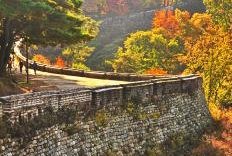
When my plane landed on Incheon International Airport, a flight attendant informed me a shocking message that my connecting flight had been rescheduled for 8 hours and recommended me to spend time in airline lounge or take a city tour, I decided to combine both recommendations by had breakfast, took a shower in the lounge, gathered all transportation information by airport free Wi-Fi and then went to Namhansanseong, this year new World Heritage Site. Since this is not my first time in Seoul, I promptly took a comfortable airport rail to Seoul Station and directly took a metro system to Sanseong Station. From exit no.2, I just followed a group of hikers to a nearby bus stop and took bus no.9 and within 30 minutes I was arrived in my destination, Namhansanseong. The bus stop was located in the center of tourist village with many restaurants and cafes. I was confused and did not know where I should go. At first I planned to follow other tourists but they went to every direction! I saw a sign mentioned about a palace so I decided to visit the place, the palace turned out to be a very new rebuilt and still a construction site, and suddenly I saw an elderly hiker using a small lane behind the palace's shrubby garden so I decided to follow him. Unknowingly I entered one of the hiking routes to the Westgate, along the way I saw a nice traditional pavilion in the middle of beautiful …
Keep reading 0 comments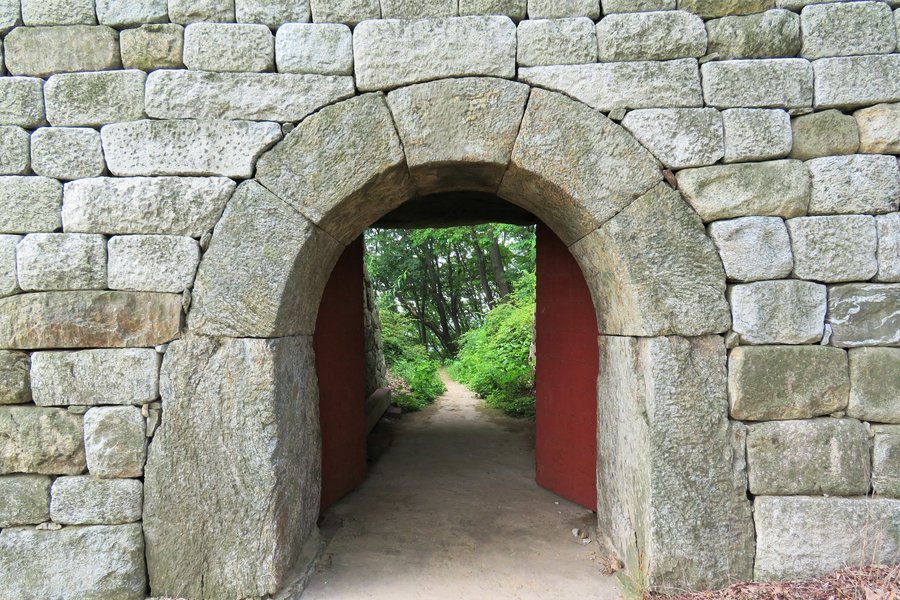
This is where Joseon paid for its loyalty and mutual bond with the Ming Dynasty. A national disaster, the siege at Namhansanseong ended in a bitter defeat. Hostages were taken to Shenyang and the Joseon Royal Family was humiliated.
Despite Namhansanseong being a location of shame, the fortress is impressive, the gates certainly stand out, and the view of Seoul from the South is stunning on a clear day. The fortress today is primarily from 1624, but fortifications have been located here since Baekje and Silla in the 7th century.
The fortress played a major role during the Joseon dynasty, acting as the protective barrier of Southern Seoul, and more importantly as a temporary palace and headquarters for the king in times of peril. (In which purpose it was used on occasion) Namhansanseong itself is one of the better preserved fortresses in Korea. The walls are higher than most, while many of the gates are particularly formidable. The primary rebuilding phase is largely a response to the Japanese invasion of 1592, and the probability of Manchu incursions (which did occur in the 1630's).
I did notice one section of the wall was being almost completely rebuilt, but for the most part, the fortress is highly authentic. (More 'original' than Hwaseong Fortress). The outer wall fortress, which was taken by the Manchu forces is largely in ruins.
There are a select few original wooden buildings, but most have been rebuilt or restored over the centuries. The Temporary Palace is the primary …
Keep reading 0 comments
